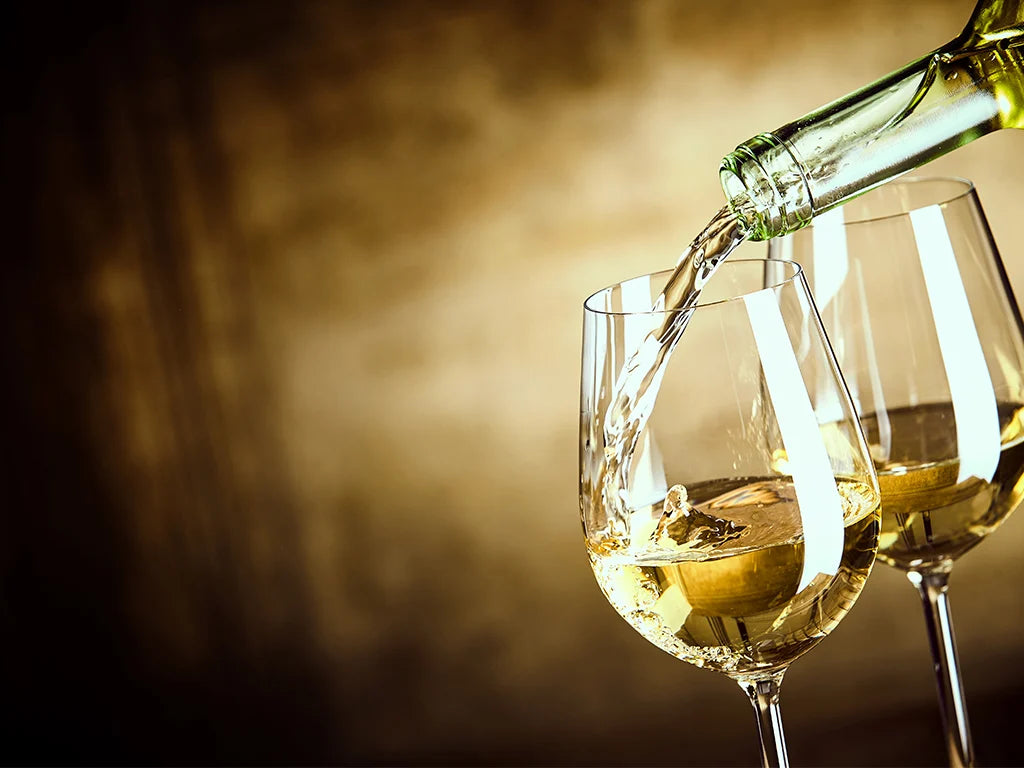White wine is under-appreciated. Still, it’s more versatile than red wine and equally complex. White wine has a place on every table and can rise to the most high-browed occasions. From everyday sippers to authentic collectors’ pieces, white wine can do it all, and the more you know about it, the more you enjoy it!
Here’s our guide to types of white wine. It’s much more than wine grapes, though; we’re talking about winemaking techniques, tradition, climate and terroir. There are many types of white wine, from dry white wine types to dessert wines to satisfy your sweet tooth.
What is white wine? What makes each white wine type different? And most importantly, how to choose the right bottle of white wine? Here’s all you wanted to know about those pale wines that can turn any reunion into a party. White wine can really do it all, and you’ll definitely see the category differently after reading this thorough guide. Are you ready to learn all there is about white wine?
How Is White Wine Made?
White wine is unique in the wine world. There are hundreds of different white-skinned varietals in the world, and each is best suited for its climate. White grapes generally ripen better in cold temperatures, but some can withstand the fiercest of summers.
Leaving the grape aside, all white wines are made with white grapes picked at maturity and pressed to obtain a pure, sweet grape juice. The grapes’ stems, seeds and skins are discarded at this stage. This doesn’t happen with red grapes destined to become red wine, in which the grape juice is fermented with the skins.
Winemakers must then ferment the sugar-rich juice, more often than not, in temperature-controlled stainless-steel tanks to the desired sweetness level. Some white wines spend time in oak barrels, and others go through the malo-lactic fermentation that rounds the wine’s acidity and blesses it with creamy, dairy-like aromas. However, most white wines never see oak and are meant to be enjoyed young — up to three years after harvest.
Types of White Wine, Explained
There are many ways of classifying white wine. You can do so by their sweetness level or the grape used; you can classify white wines for their ability to age or by their acidity. To make things easier, let’s explore the most common white wines based on the grape variety used and learn how they’re all unique.
Light, Dry White Wine Types
Sauvignon Blanc. This French grape variety offers herbaceous, citrus and sometimes tropical scents over a dry, crisp and thirst-quenching palate.
Pinot Grigio. This Italian specialty is known for its peach scents and tart, dry palate. Not overly complicated, Pinot Grigio is crowd-pleasing and rarely disappoints.
Vermentino. Known as Ugni Blanc in France, this Mediterranean varietal is often used to make brandy, but it also produces zesty white wines.
Unoaked Chardonnay. Chardonnay is relatively light and fruity when unoaked, often with floral hints and apple flavours.
Albariño. Universal in North-western Spain and Portugal, this varietal is adapted to the cold and rainy Atlantic coast. Albariño produces zesty and citrusy dry white wines that are perfect for seafood.
Chenin Blanc. Chenin Blanc is the most prominent white grape in the Central Loire Valley, a source of sparkling, dry and sweet wines. Floral and woolly, this is a unique wine grape.
Grüner Veltliner. An Austrian specialty with zippy acidity, citrus and herbal undertones and hints of white pepper over a dry palate. These wines can be young and lively or immensely contemplative.
Medium and Full-bodied White Wine Types
Verdejo. The leading grape in Spain’s Rueda wine region. Verdejo produces medium-bodied white wines with golden apple aromas and hints of herbaceousness.
Chardonnay. The most planted white grape in the world and the most favoured white variety. Chardonnay often produces bold white wines aged in oak. These are amongst the most age-worthy white wines in the world.
Viognier. This is a unique grape native to the Rhône Valley in France. Viognier produces aromatic white wines with a floral character over a medium- to full-bodied, dry palate.
White Rioja. Most white wines in the Spanish region of Rioja are made with Viura and can be pretty bold and age-worthy, especially if aged in oak.
Aromatic White Wines
Gewürztraminer. You’ll find this varietal in Northern Italy, across the Alps, Germany and Alsace. This is one of the most aromatic wine grapes and offers citrus peel and floral aromatics, often over a dry or slightly sweet palate.
Riesling. Riesling is the queen of cold climate wine regions and a specialty in Germany, Alsace and Austria. Riesling also produces excellent wines in Australia and America. Petrol and floral aromas are standard in Rieslings, and they can vary in sweetness.
Moscato. An ancient Mediterranean varietal that produces some of the most luscious white wines on the planet, although it can also be vinified as a dry white and sparkling wine.
Different Types of Sweet White Wine
Winemakers have many ways of making sweet white wine. Here are some of the most common.
Late Harvest White Wines. These wines are made with grapes left on the vines well after their peak maturity to gain sugar concentration. Even harvesting the grapes a few weeks later can be enough to produce wines with a noticeable sweetness.
Passified White Wines. You’ll commonly found these wines in Italy. The winemakers harvest the grapes and let them dry in special rooms where they lose moisture and gain sugar concentration.
Ice Wine. This unique white wine style is only possible in the coldest wine regions. The grapes are harvested when frozen solid; they’re then pressed, eliminating a great deal of ice shards, leaving a sweet syrup behind.
Botrytised White Wine. Winemakers produce this sweet white wine style with grapes infected by the noble rot or botrytis cinerea. The fungus desiccates the grapes, increasing their sugar concentration. Wines made with this ancient technique are often amongst the most coveted and expensive wines on earth.
French Dry White Wine Types
As you might already know, white wine is a big deal in France, but winemakers here don’t care much about the grapes used — they care more about the terroir. That’s why you won’t find the name of the wine grape anywhere on the label. It comes without saying it pays to know your French white wine appellations.
Muscadet. This French appellation along the Atlantic coast is crisp and almost saline. Made with Melon the Bourgogne, this is the perfect white wine for oysters and other fresh seafood specialties.
Chablis. This is cold-climate Chardonnay from some of the northernmost vineyards in the word. Mineral and acidic, this is one crisp white wine.
Mâconnais. A great value and a warm-climate expression of French Chardonnay, this region lies south of the prestigious vineyards in Burgundy. The finest appellation in the area is Pouilly-Fuissé.
Montrachet. The most significant expression of Chardonnay in the world, this Grand Cru appellation in Burgundy, represents the best of the best in the French repertoire.
Vouvray. This appellation in the Loire Valley specialises in sparkling and still white wines, bone dry and sweet, made with Chenin Blanc.
Entre-Deux-Mers. This appellation covers a broad area between the Dordogne and the Garonne Rivers in Bordeaux. Expect an inexpensive, easy-to-drink white wine made primarily with Sauvignon Blanc.
Graves. Amongst the boldest white wines in France, this appellation in Bordeaux specialises in wines made primarily with Sauvignon Blanc and Semillon. The best examples see oak ageing.
Fumé Blanc. Fumé Blanc is a French appellation in the Loire Valley for wines made with Sauvignon Blanc. The region’s white soils give the wine a flinty character.
Sancerre. Sancerre is one of the most refreshing herbal and mineral white wines made with Sauvignon Blanc. You’ll find this region in the Loire Valley close to Fumé Blanc.
Alsace. Alsace is the only wine region in France that labels its wine by grape in German fashion. Riesling, Pinot Blanc, Pinot Gris and Gewürztraminer are the most popular white wine grapes in the area.
White Wines to Try
Here’s a selection of white wines from World Wine’s catalogue, all of them worthy examples of the category. Try them all and become a white wine expert!
Dog Point Chardonnay, New Zealand
Domaine Christian Salmon Sancerre, France
Trimbach Riesling Reserve, France
Dry River Gewurztraminer, New Zealand
Albert Mann Cuvee Albert Pinot Gris Alsace, France
Baumard Coteaux du Layon ‘Carte d’Or,’ France
Let’s Show Some Love to White Wine!
White wine is versatile at the table, easy to enjoy, often affordable and incredibly rewarding. There’s no doubt white wine is up there with the most outstanding red wines on the planet, and it’s time we show it some love! After all, white wine is as complex and sophisticated as red, rosé, sparkling and sweet wines.
Enjoy your favourite types of white wines at every opportunity. Unlike most other wine styles, white wine always has your back. Choose with your eyes closed, white wine is noble like that – it will never let you down!

